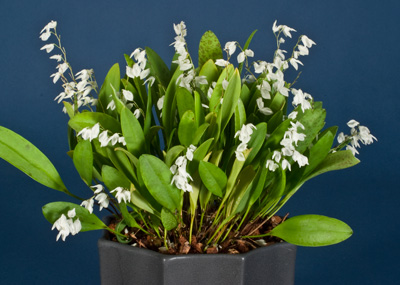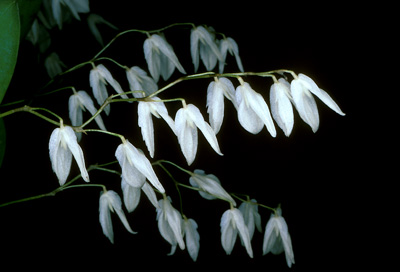Pleurothallis pterophora
'Stony Point'

by Marni Turkel / Originally Published in Orchids Magazine
| Hybrid Flask List |
| Orchid Programs |
 Pleurothallis pterophora 'Stony Point' |
One of the great pleasures of growing orchids is seeing a full flush of flowers on a beautifully grown plant. Sometimes it is surprisingly easy to coax a good display of flowers but a bit harder to get the beautiful plant. Masdevallia lamprotyria is a case in point: It is floriferous but prone to leaf-tip burn and leaf spotting.
The name comes from the Greek lampro (bright) and tyrius (purple) referring to the vibrant color of the glossy 11/2-inch flowers. It was discovered in 1978 in the Andes of northern Peru at 6,562 feet (2,000 m) and has not as yet been found elsewhere. In nature, it blooms during the rainy season (January to May) and in cultivation, it flowers in the spring.
If you are interested in trying your hand, there are several horticulturally related species in addition to Masdevallia lamprotyria that have the same narrow-foliaged free-flowering habit and irritating propensity for unsightly leaves that can mar a specimen plant. While I find Masd. lamprotyria to be the showiest of these plants, the 3-inch (7.5 cm) tall Masdevallia roseola can be a close second, with flowers from a light rose to a dark red. It is from southern Ecuador and northern Peru at 4,920 to 5,900 feet (1,500 to 1,800 m) and blooms from late summer to early autumn in cultivation. The other two species discussed here have white to off-white flowers and are more widespread in nature. Masdevallia pumila, whose name refers to its dwarf habit, was described in 1838. It is a fairly common species that occurs from Colombia to Bolivia and ranges from 4,920 to 6,560 feet (1,500 to 2,000 m). Masdevallia tubulosa is a variable species that is found from Venezuela to Peru and is generally considered a high-elevation species from 8,200 feet (2,500 m), but some plants come from as low as 3,600 feet (1,100 m).
General Masdevallia culture applies to these cloud forest plants. They will do well with moderate light (where a hand held 12 to 18 inches [30.5 to 45.75 cm] above the plant casts a diffuse shadow) and good-quality water.
Provide a buoyant atmosphere with approximately 60 percent humidity and constant air movement. For potted plants, use a half-strength fertilizer at every other watering during spring and summer and less often in autumn and winter. It is best to avoid daytime temperatures above 80 F (27 C) for extended periods of time. Potted plants should have fairly even moisture at the roots and be watered as the medium approaches dryness.
|
POTTING My basic bark mix for the genus Masdevallia is six parts washed and sifted fine fir bark, two parts medium perlite, two parts medium tree-fern fiber and one part charcoal, though any fine bark mix should work well provided it drains freely and does not become soggy. I have grown potted plants successfully for up to one year in New Zealand sphagnum moss in net pots and in nonporous ceramic and plastic pots. If growing in a greenhouse with adequate humidity, mounted plants do well with a little moisture-retentive material (such as sphagnum moss) at the roots and can be allowed to dry somewhat between waterings.
The key to growing these plants well appears to be making sure the potting medium is never allowed to deteriorate, because these plants lose their roots easily. A good-quality potting medium and frequent repotting (perhaps once a year) will go a long way toward producing good-looking plants and will also help prevent damage from bush snails. Because frequent repotting isn’t my strong point, I prefer to grow them mounted on a piece of cork or fir bark, as this prevents stale conditions at the roots as well as displaying the flowers beautifully. I water mounted plants more often than potted plants, but fertilize both at the same time. This means that mounted plants are flushed more frequently with fresh water than potted plants and this may explain why mounted plants grow cleaner for me. Masdevallia lamprotyria, Masd. pumila and most clones of Masd. tubulosa will grow in cool to intermediate conditions (minimum winter night temperatures of 50 to 58 F [10 to 14 C] and day temperatures in the 70s F [21 C]). Masdevallia roseola has grown well with 52 F (11 C) minimum nights, but is probably the most adaptable species for warmer conditions. As with any Masdevallia, care must be taken to avoid an infestation of aphids because they can rapidly spread bean yellow mosaic virus.
Mostly Species / Orchids and Flasks | Santa Rosa, CA 95407
© Marni Turkel 2003-2022 All rights reserved
